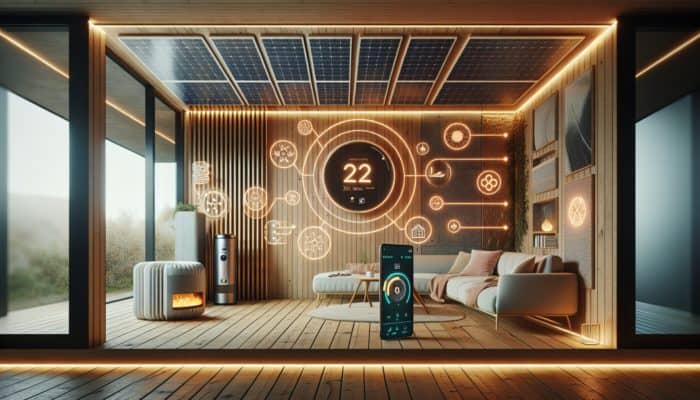Discover Proven Techniques for Home Heating During Power Interruptions
Understanding Grid-Down Heating: Mechanisms and Benefits

Grid-down heating includes a variety of both innovative and traditional methods designed to keep your home warm during power outages caused by failures in the electrical grid. When the grid is down, relying on standard heating systems becomes unfeasible. Therefore, it’s essential to explore alternative strategies to maintain warmth and comfort in our living spaces. Traditional solutions such as wood stoves are complemented by modern technologies that harness renewable energy sources for effective heating solutions. Key options for grid-down heating include:
- Wood stoves
- Propane heaters
- Solar-powered heating systems
- Portable kerosene heaters
- Passive solar heating
- Electric blankets
- Radiant floor heating systems
- Thermal mass heating
By thoroughly understanding these diverse options, individuals can prepare effectively for the challenges of a grid-down scenario, ensuring a warm and inviting home environment even during emergencies.
The Importance of Grid-Down Heating for Health and Security
Implementing grid-down heating offers advantages that go beyond mere comfort during outages. Remaining warm when conventional heating systems fail is crucial to health and safety, especially during extreme weather conditions. The key benefits of grid-down heating encompass:
- Prevention of hypothermia and other serious health threats
- Enhanced comfort in living environments
- Independence from the conventional electrical grid
- Cost savings during emergencies
- Utilisation of renewable resources
- Increased home value through improved energy efficiency
- Strengthened community resilience and preparedness
- A variety of available heating options
These compelling benefits underscore the importance of investing time and resources into developing a thorough grid-down heating plan that ensures the safety and comfort of all household members, ultimately fostering a secure living environment.
Identifying Potential Challenges in Grid-Down Heating Implementation
While the benefits of grid-down heating are numerous, there are challenges that may arise during the implementation of these systems. One of the main challenges involves securing alternative energy sources, which may not always be readily available. Additionally, effective insulation is crucial for retaining the warmth produced within the living space. Other notable challenges include:
- Securing adequate fuel supplies for prolonged use
- Understanding local regulations related to heating systems
- Potential safety hazards linked to alternative heating methods
- Initial costs associated with equipment installation
- Spatial limitations for certain heating solutions
- Maintenance requirements for heating systems
- Knowledge gaps regarding the operation of non-traditional systems
Recognising these challenges is vital for effective planning and preparation, ensuring the successful implementation of grid-down heating solutions while safeguarding the comfort and health of all residents.
Expert Insights for Maximising Your Grid-Down Heating Approach

Best Practices for Effective Grid-Down Heating
To implement efficient practices for grid-down heating, one must engage in thorough preparation, select the right equipment thoughtfully, and possess a comprehensive understanding of your home’s heating needs. Preparation is essential; it involves assessing your home’s insulation and identifying possible heating sources. When devising your grid-down heating strategy, focus on the following actionable steps:
- Evaluate insulation levels and upgrade where necessary
- Select equipment that aligns with your specific heating requirements
- Store alternative fuels in safe and accessible locations
- Conduct regular maintenance on heating devices
- Understand and comply with local heating regulations
- Test heating systems periodically to ensure proper functionality
- Develop a comprehensive heating plan that includes backup options
- Educate all household members on safe heating practices
By following these recommended practices, individuals can effectively manage the uncertainties that may arise during grid-down scenarios, ensuring warmth and safety for themselves and their families in challenging situations.
Strategies for Enhancing the Efficiency of Grid-Down Heating
Maximising the efficiency of grid-down heating is paramount to enhancing comfort while minimising resource consumption. Efficiency can be attained through various strategies. A fundamental approach involves ensuring comprehensive insulation throughout your home, which helps retain heat and reduces the strain on heating systems. Focus on the following areas:
- Sealing gaps around windows and doors
- Insulating walls, attics, and basements
- Installing thermal curtains to minimise heat loss
- Selecting appropriately sized heating equipment
- Adjusting heating levels based on occupancy
- Incorporating smart thermostats for improved control
- Regularly maintaining heating equipment for optimal performance
- Utilising fans to evenly distribute heat
By implementing these strategies, individuals not only improve heating efficiency but also enhance overall comfort during outages, ensuring that everyone remains warm and secure.
Latest Innovations in Grid-Down Heating Solutions

The field of grid-down heating solutions is continually advancing, with a range of innovations enhancing both efficiency and accessibility. Notable advancements include solar-powered heating systems that harness renewable energy to sustain comfortable indoor temperatures, even during power failures. Other exciting innovations include:
- Advanced insulation materials providing superior thermal resistance
- Portable heating solutions such as compact propane or kerosene heaters
- Hybrid systems integrating multiple energy sources for versatility
- Smart heating systems leveraging IoT technology for optimised performance
- Mobile applications for monitoring and controlling heating systems remotely
- Battery storage systems that capture solar energy for later use
- High-efficiency wood-burning stoves designed to minimise emissions
- Community-based heating solutions that pool resources for collective benefit
These innovations not only enhance the efficiency of grid-down heating but also reflect a growing commitment to sustainable and resilient living practices.
Essential Safety Protocols for Grid-Down Heating Systems
Prioritising safety is critical when employing grid-down heating solutions, as many alternative heating methods can pose risks if not managed properly. Essential safety protocols should include ensuring adequate ventilation to prevent gas accumulation, especially when using propane or kerosene heaters. Key safety measures encompass:
- Installing carbon monoxide detectors in living areas
- Regularly checking fuel sources for leaks
- Storing fuel in safe, designated areas
- Educating household members on emergency protocols
- Keeping combustible materials away from heating devices
- Monitoring temperatures to prevent overheating
- Following manufacturer guidelines for equipment usage
- Planning exit routes in case of fire emergencies
By implementing these comprehensive safety measures, individuals can mitigate risks and create a safer environment during grid-down scenarios, ensuring the protection of their homes and loved ones.
Leveraging Community Resources for Enhanced Grid-Down Heating Solutions
Utilising community resources can significantly enhance the effectiveness of grid-down heating strategies. Communities can work together to establish shared heating centres, serving as safe havens during prolonged outages. This cooperative approach enables residents to pool resources, ensuring access to essential heating supplies and equipment. Effective strategies might include:
- Creating cooperative agreements for sharing heating resources
- Establishing community training programs on alternative heating methods
- Implementing local initiatives to stockpile heating fuel
- Developing communication networks to share real-time information during outages
- Designating safe community heating locations
- Encouraging local governments to support emergency heating plans
- Promoting awareness of available heating options within the community
- Fostering community resilience through preparedness workshops
By tapping into community resources, individuals can enhance their preparedness for grid-down scenarios, ensuring that everyone has access to vital heating solutions when needed most.
Key Preparations for Effective Grid-Down Heating
Critical Components for Your Grid-Down Heating Kit
A well-prepared grid-down heating kit is vital for ensuring comfort and safety during power outages. This kit should include a variety of items that address immediate heating needs while also providing comfort during extended disruptions. Key components for a grid-down heating kit comprise:
- Portable heaters (electric or propane)
- Blankets and sleeping bags for warmth
- Alternative fuel sources (wood, propane, kerosene)
- Battery-powered or solar-powered lights
- Thermal curtains to minimise heat loss
- Basic first aid supplies
- Carbon monoxide detectors
- A manual for emergency heating techniques
By assembling these essential items ahead of time, individuals and families can ensure they are well-prepared for unexpected grid-down situations, significantly enhancing their safety and comfort during challenging times.
Choosing the Right Equipment for Efficient Grid-Down Heating
Selecting appropriate grid-down heating equipment is critical for ensuring effective heating during outages. Several factors must be taken into account, including the size of the area to be heated, the anticipated duration of the outage, and the types of alternative energy sources available. When evaluating options, key considerations should encompass:
- Assessing the size and layout of your living space
- Determining the heating method that aligns with available resources
- Evaluating the portability and ease of use of the equipment
- Considering fuel efficiency and cost-effectiveness
- Reviewing the safety features of heating devices
- Researching product reviews and performance ratings
- Inquiring about local regulations concerning heating equipment
- Investigating warranty and support options
By making informed decisions in these areas, individuals can develop a more effective and reliable grid-down heating strategy that meets their specific needs.
Essential Safety Measures for Grid-Down Heating Solutions
Implementing safety measures for grid-down heating is critical to prevent accidents and ensure a secure living environment. Key actions to ensure safety include:
- Ensuring proper ventilation for any combustion-based heating equipment
- Maintaining accessible fire extinguishers
- Regularly inspecting fuel storage areas for leaks or deterioration
- Establishing a routine for checking and maintaining heating equipment
- Educating household members on emergency procedures
- Keeping the area around heating devices clear of flammable materials
- Using only manufacturer-approved fuels for heating devices
- Establishing a designated emergency exit path
By adopting these precautions, individuals can create a safer environment and significantly reduce the risk of incidents during power outages, thereby safeguarding their homes and families.
Exploring Various Grid-Down Heating Solutions
Understanding Different Grid-Down Heating Options
Numerous effective types of grid-down heating solutions exist, each providing unique advantages and considerations for use. Understanding these options enables individuals to select the most suitable method based on their specific needs and available resources. Common types of grid-down heating include:
- Wood stoves: Versatile units that can provide significant heat, though they require a steady supply of wood and proper installation.
- Propane heaters: Portable solutions offering quick heating but necessitate safe fuel storage and adequate ventilation.
- Solar-powered systems: These harness renewable energy and depend on sunlight, typically usable only during daylight hours.
- Kerosene heaters: Effective for smaller spaces, easy to transport but require careful handling due to fuel volatility.
- Electric blankets: Ideal for personal warmth, beneficial during short outages but rely on battery or generator power.
- Radiant floor heating: A more permanent solution that can be installed in homes, although it requires initial investment and appropriate infrastructure.
- Passive solar heating: Utilises architectural features to harness sunlight, providing a sustainable heating solution.
- Thermal mass heating: Systems that absorb and store heat, helping maintain warmth in living spaces.
By comprehending the characteristics and benefits of each heating type, individuals can make informed choices that align with their specific situations and heating requirements.
Maximising Wood Stove Effectiveness for Grid-Down Heating
Wood stoves remain a reliable and traditional method for heating during power outages. Their effectiveness lies in their capacity to deliver consistent warmth when the electrical grid fails. To effectively utilise wood stoves, several key considerations should be addressed:
- Ensure a steady supply of seasoned wood for burning, optimising heat output while minimising smoke emissions.
- Install the wood stove according to the manufacturer’s guidelines to ensure safety and efficiency.
- Maintain proper ventilation to prevent carbon monoxide accumulation, and install a carbon monoxide detector nearby for added safety.
- Keep the area around the stove clear of flammable materials to avoid fire hazards.
- Educate all users on the proper operation of the stove, including how to safely build and maintain a fire.
- Regularly clean and inspect the chimney and flue to prevent soot buildup and reduce fire risk.
- Consider using a heat-powered stove fan to enhance heat distribution throughout the living space.
- Keep a fire extinguisher readily available in case of emergencies.
By adhering to these guidelines, individuals can maximise the effectiveness and safety of wood stoves as a grid-down heating solution, ensuring warmth and comfort for their households.
Utilising Solar Energy for Effective Grid-Down Heating
Harnessing solar power for grid-down heating is gaining traction, especially with advancements in technology. Solar energy can be utilised to maintain warmth through various methods, including solar panels connected to heating systems and solar thermal collectors. To effectively leverage solar power for heating, consider the following:
- Install solar panels that convert sunlight into electricity to power electric heaters or heat pumps.
- Utilise solar thermal systems that capture sunlight to heat water, which can then be circulated for radiant heating.
- Invest in battery storage systems to retain excess energy generated during sunny days for use during night-time or cloudy weather.
- Design the solar heating setup to optimise sunlight exposure through proper placement and orientation.
- Regularly clean and maintain solar panels to maximise efficiency and energy output.
- Consider passive solar heating techniques by designing your space to maximise natural light and heat absorption.
- Educate yourself on local regulations and incentives for solar installations to maximise benefits.
- Collaborate with neighbours to share resources and knowledge about solar heating solutions.
By embracing solar power as an effective grid-down heating method, individuals can significantly enhance their resilience while utilising an environmentally friendly energy source, contributing to sustainable living practices.
Maintaining Comfort During Grid-Down Heating Situations
Strategies for Sustaining Indoor Temperatures Effectively
Maintaining indoor temperatures during a grid-down heating scenario is essential for comfort and safety, making effective strategies crucial for managing heat retention in living spaces. Key practices to sustain warmth include:
- Sealing drafts around windows and doors to prevent heat loss.
- Utilising thermal curtains or insulated window coverings to trap heat indoors.
- Employing area rugs on bare floors to add insulation and warmth.
- Placing heating sources in central locations to maximise heat distribution.
- Utilising fans to circulate warm air and prevent temperature stratification.
- Monitoring indoor temperatures with thermometers to adjust heating levels accordingly.
- Encouraging family members to dress warmly to reduce heating demands.
- Implementing a schedule for heating equipment use to conserve fuel.
By adopting these practices, individuals can create a more comfortable indoor environment, ensuring warmth is preserved even in challenging conditions.
Effective Insulation Techniques for Enhanced Grid-Down Heating
Implementing effective insulation methods plays a crucial role in conserving heat during grid-down heating situations. Adequate insulation minimises the need for excessive heating, conserving resources while maintaining comfort. Effective insulation techniques include:
- Adding insulation to attics, walls, and basements to reduce heat loss.
- Employing weather stripping around windows and doors to create airtight seals.
- Installing thermal curtains that retain heat at night and block cold drafts.
- Using foam board insulation in critical areas for enhanced thermal resistance.
- Covering windows with clear plastic film to create an insulating layer.
- Incorporating rugs and carpets to provide additional insulation on floors.
- Using draft stoppers or door sweeps to block cold air from entering through gaps.
- Regularly inspecting insulation for damage or deterioration and making necessary repairs.
By employing these insulation techniques, individuals can maximise their grid-down heating efforts and ensure a stable indoor climate, enhancing overall comfort during power outages.
Managing Heat Distribution for Optimal Comfort in Your Home
Effective heat distribution is essential to ensure warmth reaches all areas of the home during grid-down heating situations. To achieve optimal heat distribution, several strategies can be executed:
- Position heaters strategically in central locations to maximise heat flow throughout the space.
- Utilise fans to help circulate warm air from heating sources, especially in larger areas.
- Keep interior doors open to facilitate airflow and prevent temperature disparities between rooms.
- Consider installing ceiling fans that can be reversed to push warm air down from the ceiling.
- Use heat-powered stove fans on wood stoves to increase airflow without using electricity.
- Organise furniture to promote air circulation around heating devices.
- Implement zoning strategies with portable heaters to heat specific areas as necessary.
- Regularly monitor and adjust heating sources based on comfort levels throughout the home.
By utilising these techniques, individuals can create a more uniformly heated environment, enhancing comfort during grid-down scenarios and ensuring that every family member stays warm and secure.
Key Best Practices for Safe Use of Alternative Heating Sources
Utilising alternative heating sources necessitates adherence to best practices to ensure safety and efficiency. To maximise effectiveness while minimising risks, consider the following guidelines:
- Read and follow all manufacturer instructions for proper operation and safety.
- Ensure adequate ventilation for combustion-based heating devices to prevent carbon monoxide build-up.
- Maintain a safe distance between heating devices and flammable materials.
- Use heating equipment that is appropriately sized for the space being heated.
- Regularly inspect and maintain equipment to prevent malfunctions and hazards.
- Educate all household members on safe heating practices and emergency procedures.
- Store alternative fuels in safe and designated areas away from living spaces.
- Keep fire extinguishers within reach of heating sources for emergencies.
By following these best practices, individuals can safely utilise alternative heating sources and maintain comfort during grid-down scenarios, ensuring their homes remain warm and secure.
Research-Based Benefits of Grid-Down Heating
The Role of Grid-Down Heating in Enhancing Safety During Outages
Grid-down heating is crucial for enhancing safety during power outages, particularly in colder climates. The ability to maintain warmth can prevent severe health issues such as hypothermia and frostbite. Research highlights the essential role of grid-down heating in sustaining safe living conditions. Real-world examples indicate how effective grid-down heating strategies have mitigated cold-related health emergencies, especially during severe winter storms:
- Individuals with access to alternative heating maintained safer indoor temperatures.
- Communities implementing shared heating programs reduced the incidence of hypothermia.
- Access to reliable heating sources has been linked to decreased emergency room visits during winter outages.
- Prepared households report higher levels of comfort and reduced anxiety during power failures.
Investing in grid-down heating capabilities is fundamentally an investment in the health and safety of the community, ensuring individuals remain shielded during extreme weather conditions and outages.
Environmental Considerations of Grid-Down Heating Solutions
The environmental impacts of grid-down heating can vary significantly based on the methods employed. Some heating solutions, particularly those reliant on fossil fuels, can lead to adverse environmental consequences, including air pollution and greenhouse gas emissions. However, more sustainable options, such as solar-powered systems, provide eco-friendly alternatives. Key considerations include:
- Wood stoves can contribute to air pollution if not properly managed, yet sustainably sourced wood can mitigate this.
- Solar energy options reduce dependence on fossil fuels and have a minimal environmental footprint.
- Propane and kerosene systems can serve as cleaner alternatives, but careful management is essential.
- Investing in efficient appliances helps minimise energy consumption and waste.
- Utilising thermal mass heating takes advantage of natural resources to reduce energy use.
- Community initiatives promoting renewable energy sources can lessen the environmental impact of heating practices.
- Research supports the transition to greener heating solutions to foster environmental sustainability.
- Understanding the life cycle of heating solutions is critical for assessing their overall environmental impact.
By selecting environmentally conscious heating methods, individuals can contribute to a more sustainable future while effectively managing their heating needs during outages.
The Impact of Grid-Down Heating on Mental Well-Being
Maintaining warmth during power outages positively influences mental well-being, particularly in stressful circumstances. Research indicates a strong correlation between comfortable living environments and reduced anxiety levels. The psychological benefits of grid-down heating can be substantial, as warmth not only supports physical comfort but also fosters emotional resilience. Actionable steps to enhance mental well-being through grid-down heating include:
- Creating cosy environments with blankets, candles, and soft lighting to cultivate a sense of security.
- Encouraging social interactions and community engagement during outages to lessen feelings of isolation.
- Establishing routines that incorporate warm meals and activities to maintain a sense of normalcy.
- Offering support to vulnerable community members, thereby enhancing collective resilience.
- Utilising available heating resources to create safe communal spaces.
- Educating individuals on stress management techniques during emergencies.
- Promoting awareness of the mental health benefits of remaining warm and connected.
- Documenting personal experiences to build resilience and preparedness for future outages.
By prioritising warmth and comfort, individuals can foster an environment that supports both physical and mental well-being during grid-down scenarios, ultimately enhancing quality of life during challenging times.
The Influence of Grid-Down Heating on Energy Efficiency
Implementing grid-down heating solutions can substantially boost energy efficiency by reducing reliance on traditional power sources. By adopting alternative heating methods, households can lower their energy consumption, thereby decreasing utility bills and minimising their environmental footprint. Key aspects of energy efficiency include:
- Using energy-efficient heating devices that consume less fuel for the same output.
- Implementing energy conservation practices that reduce overall heating needs.
- Choosing renewable energy sources that offer sustainable heating options.
- Employing smart technologies to monitor heating usage and improve performance.
- Upgrading insulation and sealing drafts to enhance overall home efficiency.
- Encouraging community-based energy solutions that promote resource sharing.
- Evaluating and adjusting heating strategies based on actual energy usage data.
- Promoting education on energy-efficient practices within households and communities.
By concentrating on energy efficiency, individuals can create healthier living environments while contributing to broader energy conservation efforts and sustainability initiatives.
Economic Benefits of Grid-Down Heating Solutions
Implementing grid-down heating solutions can yield considerable economic advantages, particularly during power outages. The ability to maintain warmth and comfort without relying on the conventional power grid translates into significant cost savings. An examination of these economic benefits encompasses various factors, including:
- Reduced energy bills during outages by utilising alternative heating sources.
- Potential government incentives for adopting renewable energy systems.
- Lower costs of heating fuel when using local or renewable resources.
- Increased property value through the installation of efficient heating systems.
- Decreased emergency expenses related to health and safety during cold weather.
- Long-term savings from reduced reliance on fossil fuels.
- Community initiatives that lower costs by pooling resources for heating supplies.
- Improved financial resilience through preparedness and effective planning.
By recognising and leveraging these economic advantages, individuals can make informed decisions that enhance their comfort and financial well-being, ultimately fostering a more resilient household.
Adjusting Grid-Down Heating for Different Scenarios
Effective Strategies for Short Outages
During brief outages, quick and effective heating solutions are essential for maintaining comfort. The primary focus should be on immediate accessibility and ease of use. Best practices for adapting grid-down heating methods for short outages include:
- Utilising portable heaters that can be easily moved and set up in any room.
- Employing blankets and sleeping bags to retain body heat while waiting for power restoration.
- Keeping an emergency supply of batteries for flashlights and battery-operated heating devices.
- Stockpiling non-perishable food that can be quickly heated once power is restored.
- Using solar-powered lights for visibility while managing heating methods.
- Establishing a communication plan with family or community members for updates.
- Utilising hot water bottles to provide targeted warmth.
- Preparing a contingency plan for alternative heating methods if required.
By implementing these strategies, individuals can ensure comfort and safety even during brief power interruptions, maintaining a reassuring sense of security in challenging circumstances.
Managing Grid-Down Heating During Extended Outages
Long-term outages present unique challenges, necessitating more robust and sustainable heating solutions. Planning and preparation become crucial to ensure comfort and safety over extended periods without power. Considerations for grid-down heating during long-term outages include:
- Utilising wood stoves or solar-powered systems capable of providing consistent heating.
- Stockpiling adequate fuel supplies to ensure prolonged heating capability.
- Incorporating passive solar heating techniques to maximise natural sunlight.
- Establishing community support networks for resource sharing and collaboration.
- Investing in insulation upgrades to minimise heat loss over time.
- Educating household members on energy conservation practices to extend resources.
- Implementing a heating schedule to manage fuel consumption efficiently.
- Creating a safe community space where residents can gather for warmth and support.
These strategies can help individuals and communities navigate the challenges posed by prolonged power outages, ensuring adequate heating solutions are in place during times of need.
Considerations for Grid-Down Heating in Severe Weather Conditions
Extreme weather necessitates specialised heating solutions capable of withstanding harsh environments. Planning for grid-down heating during such events involves understanding the unique challenges presented by severe cold. Key considerations include:
- Investing in high-efficiency heating systems that can generate substantial warmth.
- Utilising backup heating options like generators for emergencies.
- Preparing insulated shelters that can retain heat during extreme temperatures.
- Securing ample firewood or fuel for sustained burning during outages.
- Implementing strict safety protocols for heating equipment to prevent accidents.
- Collaborating with local emergency services to understand available resources.
- Developing community plans for shared heating in extreme conditions.
- Educating residents on how to recognise and respond to hypothermia and cold-related health issues.
By acknowledging the specific needs associated with extreme weather, individuals can develop effective strategies that ensure warmth and safety during grid-down situations, protecting themselves and their communities.
Assessing the Cost-Effectiveness of Grid-Down Heating Solutions
Initial Costs of Implementing Grid-Down Heating Solutions
Initial costs associated with grid-down heating can vary significantly based on the chosen solutions and installation requirements. Understanding these costs is essential for effective budgeting and planning. The key components of initial costs include:
- The purchase price of heating equipment, such as stoves, heaters, or solar systems
- Installation costs that may require professional assistance for certain systems.
- Modifications to existing infrastructure, such as adding a chimney or flue systems for wood stoves.
- Costs associated with insulation upgrades to maximise efficiency.
- Initial investments in fuel supplies for heating options.
- Emergency supplies, including safety equipment like carbon monoxide detectors.
- Potential training costs for learning how to operate heating systems safely.
- Costs related to community resource-sharing initiatives.
By factoring in these initial costs, individuals can assess the overall investment required for a comprehensive grid-down heating strategy, ensuring they are adequately prepared for potential outages.
Strategies for Minimising Ongoing Costs of Grid-Down Heating
Reducing ongoing costs associated with grid-down heating is vital for maintaining sustainable practices. Implementing strategies that minimise expenses while maximising efficiency can significantly enhance affordability. Key strategies include:
- Regular maintenance of heating equipment to ensure optimal performance and longevity.
- Using energy-efficient appliances that consume less fuel for the same output.
- Implementing energy-saving practices to reduce consumption during heating events.
- Participating in community resource-sharing arrangements to lower costs.
- Monitoring fuel usage and adjusting heating strategies based on actual consumption.
- Investing in bulk purchases of fuel to obtain lower prices.
- Incorporating smart technology to monitor and control energy usage efficiently.
- Evaluating and replacing outdated heating systems with more efficient alternatives.
By focusing on these strategies, individuals can manage ongoing costs effectively while ensuring warmth and comfort during grid-down scenarios, ultimately fostering a more resilient and financially sound household.
Comparing Grid-Down Heating Solutions to Traditional Heating Methods
Comparing grid-down heating solutions with traditional heating methods is vital for understanding their cost-effectiveness and suitability for various scenarios. Key factors to consider in this comparison include:
- Energy efficiency of alternative heating methods versus traditional systems.
- Initial investment and installation costs associated with different heating options.
- The long-term savings potential derived from reduced reliance on conventional energy sources.
- Flexibility and adaptability of grid-down heating solutions during outages.
- Environmental impacts of different heating methods and their carbon footprint.
- Safety considerations associated with alternative versus traditional heating systems.
- Shared heating resources promoting community resilience over individual reliance.
- User experiences and satisfaction levels with various heating options are evaluated.
Understanding these aspects aids in making informed decisions that align with individual needs and circumstances, ensuring optimal heating solutions during grid-down events and fostering a more secure living environment.
Long-Term Financial Benefits of Grid-Down Heating Solutions
Evaluating the long-term financial benefits of grid-down heating solutions is crucial for understanding their overall cost-effectiveness. While initial investments may be significant, the potential for substantial savings and value appreciation over time warrants careful consideration. Key financial benefits include:
- Reduced energy bills due to lowered reliance on traditional power sources.
- Potential increases in property value through the installation of efficient heating systems.
- Access to government incentives and rebates for adopting sustainable heating practices.
- Long-term savings on emergency heating expenses during outages.
- Decreased costs related to health issues from inadequate heating during cold weather.
- Community initiatives that lower costs through resource-sharing arrangements.
- Enhanced financial resilience through preparedness and planning.
- Recognition of cost savings through effective energy management practices.
By assessing these long-term benefits, individuals can make informed decisions regarding their investments in grid-down heating solutions, ultimately enhancing both comfort and financial well-being in an ever-changing world.
The Future Outlook for Grid-Down Heating Solutions
Emerging Trends in Grid-Down Heating Solutions
The future of grid-down heating is shaped by several emerging trends that prioritise sustainability, efficiency, and innovation. Staying informed about these trends can assist individuals and communities in preparing for future heating challenges. Noteworthy trends include:
- The increased adoption of renewable energy sources, such as solar and wind, for heating solutions.
- Integration of smart home technologies to optimise heating performance.
- Growing interest in energy-efficient heating systems that minimise environmental impact.
- Community-driven initiatives that promote shared resources and collective resilience.
- Advancements in insulation technology that enhance heat retention.
- The development of hybrid heating systems that combine various energy sources.
- Enhanced focus on emergency preparedness planning within communities.
- Research and innovation in sustainable heating materials and practices.
These trends indicate a shift towards more resilient and sustainable heating solutions, enabling individuals and communities to navigate grid-down scenarios more effectively while maintaining warmth during power outages.
The Role of Technology in Future Grid-Down Heating Solutions
Technology is poised to significantly influence grid-down heating solutions, offering advancements that enhance efficiency, effectiveness, and accessibility. Key technological developments include:
- IoT-enabled heating systems that facilitate remote monitoring and control, optimising energy usage.
- Advancements in energy storage solutions enabling better utilisation of renewable energy sources.
- Smart thermostats and energy management systems improving heat distribution.
- Innovative insulation materials that significantly enhance thermal performance.
- Developments in heat recovery systems utilising waste heat for additional warmth.
- Mobile applications for community resource-sharing and collaborative planning.
- Research into alternative fuels that minimise environmental impact.
- Integration of machine learning algorithms to analyse energy usage patterns and enhance performance.
By leveraging these technological advancements, individuals and communities can enhance their grid-down heating strategies while fostering greater resilience against future challenges and uncertainties.
Long-Term Prospects for Grid-Down Heating Solutions
The long-term prospects for grid-down heating solutions appear promising, with an increasing focus on sustainability and community resilience. As climate change and energy challenges escalate, the significance of effective grid-down heating strategies will only grow. Key considerations for the future include:
- Wider adoption of sustainable heating methods utilising renewable resources.
- Increased community preparedness and resource-sharing initiatives to bolster resilience.
- Advancements in technology supporting more efficient heating solutions.
- Growing awareness of the importance of mental well-being during power outages.
- Investment in research and development of innovative heating materials and systems.
- Policy changes promoting renewable energy adoption and energy efficiency standards.
- Collaboration among communities to create robust emergency response plans.
- Recognition of the economic benefits associated with grid-down heating solutions.
These prospects signify a future where grid-down heating becomes a fundamental aspect of energy preparedness, enhancing comfort and safety in an ever-changing world.
Answers to Common Questions About Grid-Down Heating Solutions
Defining Grid-Down Heating: What Is It?
Grid-down heating refers to alternative heating solutions employed when the electrical grid is non-functional during outages, ensuring comfort and safety for occupants.
Advantages of Grid-Down Heating: What Are They?
The advantages include enhanced safety, comfort during outages, reduced reliance on power grids, and potential cost savings through efficient heating methods.
Challenges in Implementing Grid-Down Heating: What Should You Know?
Challenges include the necessity for alternative energy sources, proper insulation, securing fuel supplies, and understanding safety protocols associated with various heating methods.
Best Practices for Grid-Down Heating: What Are They?
Best practices consist of preparing in advance, selecting appropriate equipment, ensuring proper insulation, and conducting regular maintenance on heating systems.
Optimising Grid-Down Heating Efficiency: How Can You Do It?
Optimising efficiency involves using proper insulation, accurately sizing equipment, and implementing regular maintenance schedules to ensure peak performance.
Innovations in Grid-Down Heating Solutions: What to Expect?
Innovations include solar-powered heating systems, advanced insulation materials, and portable heating solutions designed for emergencies.
Safety Measures for Grid-Down Heating: What Are the Essentials?
Safety measures encompass ensuring proper ventilation, installing carbon monoxide detectors, and safely storing fuels away from living spaces to prevent hazards.
Community Resources for Enhancing Grid-Down Heating Strategies: How Can They Help?
Community resources can facilitate shared heating centres, cooperative energy solutions, and collaborative training programs to improve preparedness and resource availability.
Components of a Grid-Down Heating Kit: What Should Be Included?
A grid-down heating kit should contain portable heaters, blankets, alternative fuel sources, and safety equipment such as carbon monoxide detectors for emergencies.
Choosing the Right Grid-Down Heating Equipment: What to Consider?
Selecting the right equipment involves assessing your space size, the anticipated duration of outages, and the availability of alternative energy sources to ensure effective heating.
Follow Our Journey on X!
The post Grid-Down Heating: Essential Strategies appeared first on Survival Bite.
The Article Grid-Down Heating Strategies You Must Know Was Found On https://limitsofstrategy.com



